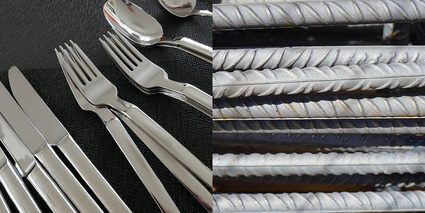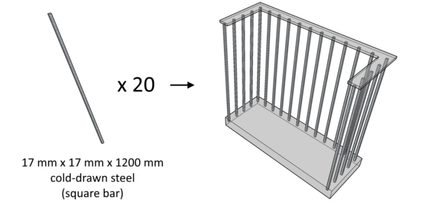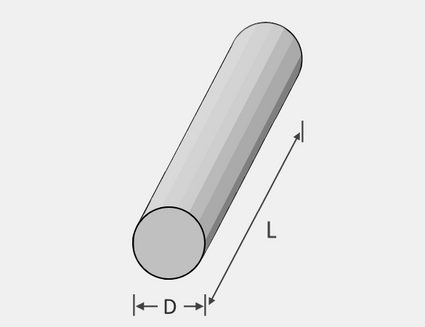Steel Weight Calculator
This steel weight calculator will help you determine the weight of steel pieces of any size, whether rods, bars, or plates. We built this calculator to work with a variety of steel types, so you'll get the steel weight you need.
In this calculator, you will learn:
- What steel is;
- The uses of steel; and
- How to calculate the weight of steel using its density and volume, just as if you were going to purchase some gravel or asphalt.
If that sounds interesting, just keep on reading!
What is steel?
Steel is a metal alloy with iron as its main component and carbon as its primary alloying element. If carbon makes up anywhere from 0.05% to a little above 2% of the total weight of steel, the iron is stronger and more ductile. The more carbon we add to iron, the stronger the steel gets (up to 2.14% carbon). Adding other alloying elements results in four major steel types — carbon steel, alloy steel, stainless steel, and tool steel.
-
Carbon steel is pretty much the most basic kind of steel since it usually only has iron and carbon in it. In some cases, carbon steel can still have some elements, but only copper, manganese, and silicon.
-
Adding other alloying elements in carbon steel results in our next steel type, the alloy steel. With other alloying elements like manganese (for additional surface hardness), molybdenum (for strength), nickel (for corrosion resistance), and so much more, we can get a more specific steel alloy that will suit our needs.
-
One specific steel alloy with unique characteristics is stainless steel. By adding a minimum of 10% chromium, which provides a barrier from rusting and oxidation, we produce stainless steel. Stainless steels are strong, hard, corrosion-resistant, and usually very shiny, too.
-
The last type is the tool steel. Tool steels are much harder and more durable because of the additional heat-treatment procedures they undergo during production. Because of their extreme properties, we can use tool steels for cutting tools, drill bits, and many other applications where the steel will be exposed to wear and tear.
Steel products and uses of steel
We see steel products almost everywhere, from our kitchen utensils to the rebars at the construction site or round pens for our animals. Steel material can be molded, machined, or combined with other materials to form almost any product we can imagine. In construction, steel is available in rods, tubes, wires, plates, and sheets. We can use steel rods as pins to connect hinged supports in steel frames and structures, or we can cut large-diameter rods to make gear "blanks."
On the other hand, we can use bars and wires for reinforcing concrete or for ornamental designs. Lastly, we can use steel plates and sheets for slabs and for the fabrication of water tanks, vaults, and molds, to name a few.

💡 Check out our separate steel plate weight calculator if you need to quickly determine the weight of steel in the form of sheets or plates.
Why do we need to get the weight of steel?
In the construction industry, we commonly price steel per unit weight, similar to other raw materials like gravel, sand, and concrete. Since steel is available in various types, shapes, and sizes, pricing steel per unit weight would mean much more consistent pricing across the market. This way of pricing is why it is essential to know the weight of steel in general.
Other than that, determining the total weight of steel products is generally beneficial, especially during transport. Buying in bulk affects the cost of most materials as we can save money by adequately organizing delivery and logistics instead of delivering small quantities on multiple trips. Aside from that, since steel can get really heavy in large volumes, calculating the steel weight is essential in the design of structures.
Steel weight calculator — How to calculate weight of steel
Determining the weight of steel only takes a few steps to accomplish. First, we need to know the density of the steel alloy we are using. In our steel weight calculator, you will find the density values for each of the most common steel alloys listed in our calculator's Steel type part. You can also see them listed here in the table below:
Steel type | Density (kg/m³) |
|---|---|
Tool steel | 7715 |
Wrought iron | 7750 |
Carbon tool steel | 7820 |
Cold-drawn steel | 7830 |
Carbon steel | 7840 |
C1020 HR steel | 7850 |
Pure iron | 7860 |
Mild steel | 7870 |
Stainless steel | 8030 |
After determining the density of the steel alloy, the next step is to obtain the total volume of our steel material. Getting the volume of our steel material depends on its shape and dimensions. By applying the necessary formulas, we can obtain the volume for rods, bars, plates, tubes, and even other complicated shapes. You can check our volume calculator for the different volume formulas for most shapes that our steel weight calculator does not cover. After obtaining the volume of steel material, we are now ready to use the formula below:
where:
- is the steel material's weight;
- is the volume of the steel material; and
- is the density of the steel alloy.
When using this formula, always make sure to multiply values with the same units of measurement. The resulting unit of measure of the volume must match the volume part in the density unit.
If you have multiple steel pieces, you can input the number of steel pieces into our steel weight calculator to get the overall steel weight. As an exercise in finding the weight of steel, let us look at an example in this text's next section.
Sample computation of steel weight
For our example, let us consider calculating the weight of some square bars needed for a set of balusters. Let's say we need to cut 20 pieces of 1.2-m long cold-drawn steel (7,830 kg/m³) square bars where the sides are 17-mm, as shown in the illustration below:

To calculate the weight of the square bars, let us first determine the volume of a square bar by getting its cross-sectional area and multiplying it by its length. Since the density of cold-drawn steel is in kilograms per cubic meter, let us find the volume in cubic meters:
Solving for its weight, we have:
To get the total weight of our square bars, we need to multiply this figure by the number of square bars needed, which is 20 pieces. Our steel square bars' total weight would then be . That's quite a workout to carry!
🙋 If you need to double-check the proper spacing of your steel bars for kid-safe balusters, definitely check out our baluster calculator to help you decide on your baluster spacing.
Want to learn more?
If you found our steel weight calculator informative and would like to learn more about the weights of other metals in general, perhaps you would also like to try our metal weight calculator. You will find much more information there about other metals, their densities, and some of their uses. We also have an aluminum weight calculator if you work on aluminum most of the time.
FAQs
How do you calculate steel weight?
To calculate the weight of a steel object, follow these steps:
-
Calculate the
volumeof the steel object. -
Look up the
densityof the steel alloy the object is made from. -
Multiply the
volumewith thedensityto get theweightof the steel object:weight = density × volumeEnsure you're using the proper units.
You can skip this manual calculation and use our steel weight calculator instead.
What is the weight of 12 mm steel?
The weight of a 12 mm diameter steel rod, assuming it is of the standard 12 m length, is 10.654 kg. Here is how you can calculate this answer:
-
Find the volume (in m3) of the 12 mm steel rod using the cylinder volume formula:
V = π⋅d2⋅l/4 = π⋅(12×10-3)2⋅12/4 = 1.3572×10-3 m3
-
Look up the steel's density. For TMT steel bars, it is 7850 kg/m3.
-
Multiply the volume with density to get the 12 mm steel weight:
W = 1.3572×10-3 m3 ⋅ 7850 kg/m3 = 10.654 kg
-
Verify this result with our steel weight calculator.
What is 162 in steel weight formula?
The steel weight formula for a cylindrical steel rod/bar is:
W = (π/4)⋅d2⋅l⋅ρ
where:
- d — Rod's diameter in m;
- l — Rod's length in m; and
- ρ — Steel's density in kg/m3.
Accounting for unit conversions and steel density of 7850 kg/m3, the following approximate formula is used for TMT steel bars:
W = d2⋅l/162
where now d is in mm and l in meters.
Here, the denominator 162 is an approximate simplification of the unit conversion and steel density:
(π/4)⋅(10-3)2⋅7850 =1/162.19… ≈ 1/162
What is the formula for weight of steel in kg/m?
The steel weight formula for a cylindrical steel/rod in kg/m is given by:
W = (π/4)⋅d²⋅ρ
where:
- d — Rod's diameter in m;
- l — Rod's length in m; and
- ρ — Steel's density in kg/m³.
An approximate formula, accounting for unit conversion and a steel density of 7850 kg/m³ is:
W = d²/162
where now d is in mm.
